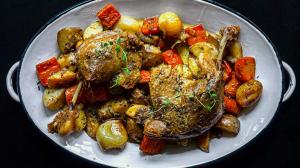The simplified method for this traditional preserving method for seasonal duck meat could easily become an alternative for an easier do-ahead prepared holiday meal. The method, that involves pre-salting, some waiting and then preserving the salted meats in fat seems simple enough but sometimes we get the ratios wrong so here’s how I do it with simple math & spices.
There are many ways out there to prepare duck confit. You can use up to 375 grams salt (or 25% of the total duck weight) to completely cover all the pieces but then so much salt goes wasted and there’s a chance it might be too salty for you. You can use only 37,5 grams (or 2,5% of the total duck weight) which is what the duck meat can actually absorb but it might not be evenly salted unless you rubbed it in everywhere, perfectly and evenly. Or you can do something in between and easier to remember and handle, like I like to do, which is 10% of the total initial weight of the duck pieces, in salt that you use.
Others add more spices and flavorings at the beginning but to have a preparation that is more versatile, less is more, so you could add more just spices and flavorings when reheating the preparation and just before serving. I also make a point of adding only dry herbs, spices and garlic granules, to avoid adding any more water/humidity to the preparation since the salt’s role is to remove part of that water in the first place.
This preparation provides you with duck legs that are so tender that the meat falls off the bone but with skin that is crisped up right before serving.
The duck fat (or goose fat) used to very gently cook the duck is also used to preserve the duck once cooled and solidified and this same flavorful fat is used to cook up the duck as well as any accompanying vegetables before serving.
Our great grandparents and grandparents ate everything that it was possible to eat and used up every bit of the sacrifice that meat represented, wasting absolutely nothing. Perhaps we should too.
And don't forget to take a look at the "holiday-spiced & salt-cured foie gras" recipe too (see recipe here) … :)



















